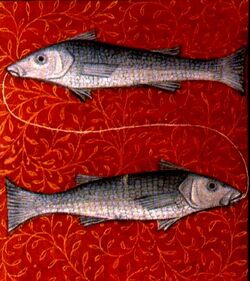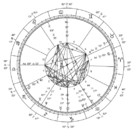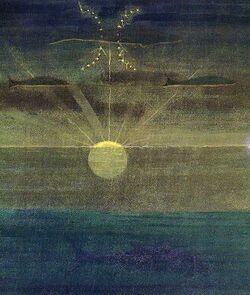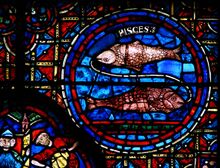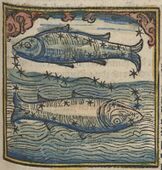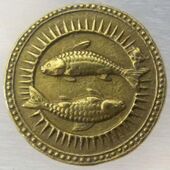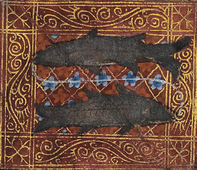Depicted in 14th century Arabic manuscript, Book of Wonders
Gold coin minted during the reign of Jahangir depicting Pisces.
Pisces (astrology)
Topic: Unsolved
 From HandWiki - Reading time: 9 min
From HandWiki - Reading time: 9 min
| Pisces | |
|---|---|
| Zodiac symbol | Fish |
| Duration (tropical, western) | February 19 – March 20 (2024, UT1)[1] |
| Constellation | Pisces |
| Zodiac element | Water |
| Zodiac quality | Mutable |
| Sign ruler | Neptune (modern) Jupiter (ancient) |
| Detriment | Mercury |
| Exaltation | Venus |
| Fall | Mercury |
| Astrology |
|---|
| Background |
| Traditions |
| Branches |
Pisces (♓️) (/ˈpaɪsiːz/;[2][3] Ancient Greek: Ikhthyes) is the twelfth astrological sign in the Zodiac. It spans 330° to 360° of celestial longitude. Under the tropical zodiac the sun transits this area between February 19 and March 20, [lower-alpha 1] and under the sidereal zodiac, the sun transits this area between approximately March 13 and April 13. In classical interpretations, the symbol of the fish is derived from the ichthyocentaurs, who aided Aphrodite when she was born from the sea.[4]
According to some tropical astrologers, the current astrological age is the Age of Pisces,[5] while others maintain that it is the Age of Aquarius.
Background

While the astrological sign Pisces per definition runs from elliptical longitude 330° to 0°,[6] this position is now mostly covered by the constellation of Aquarius, due to the precession from when the constellation and the sign coincided. Today, the First Point of Aries, or the vernal equinox, is in the Pisces constellation.[7][3] There are no prominent stars in the constellation,[3] with the brightest stars being of only fourth magnitude.[8] One star in the constellation, Alpha Piscium, is also known as Alrescha, which comes from the Arabic الرشآء al-rišā’, meaning "the well rope,"[9] or "the cord."[8] The constellation however is different from the astronomical location in where the sign occupies space. The constellations in earlier times were primarily used as markers to help determine what influence was in the sky. Nevertheless, the sign of pisces remain in the 30 degree span of 330°-0°.
Ptolemy described Alpha Piscium as the point where the cords joining the two fish are knotted together.[8] The astrological symbol shows the two fishes captured by a string,[10][11][12][13] typically by the mouth or the tails. [14] The fish are usually portrayed swimming in opposite directions; this represents the duality within the Piscean nature. They are ruled by the planet Neptune.[10][15] Although they appear as a pair, the name of the sign in all languages originally referred to only one fish with the exception of Greek, [16] Bulgarian, Dutch, Latvian, and Italian. Pisces are the mutable water sign of the zodiac. They represent emotion, intuition, imagination, escapism, romance, and impressionism.
In Sidereal astrology, the sun currently transits the constellation of Pisces from approximately March 14 to April 14.[17] Individuals born during these dates, depending on which system of astrology they subscribe to, may be called "Pisceans."[18][2]
Mythology
Divine associations with Pisces include Poseidon/Neptune, Christ, Aphrodite, Eros, Typhon, Vishnu [19] and the Sumerian goddess Inanna.
In early mythology
"Pisces" is the Latin word for "Fish."[20] It is one of the earliest zodiac signs on record, with the two fish appearing as far back as c. 2300 BCE on an Egyptian coffin lid.[21]
According to one Greek myth, Pisces represents the fish, sometimes represented by koi fish, into which Aphrodite (also considered Venus)[22] and her son Eros (also considered Cupid)[22] transformed in order to escape the monster Typhon.[3][23][20] Typhon, the "father of all monsters," had been sent by Gaia to attack the gods, which led Pan to warn the others before himself changing into a goat-fish and jumping into the Euphrates.[8] A similar myth, one which the fish "Pisces" carry Aphrodite and her son out of danger, is resounded in Manilius' five volume poetic work Astronomica: "Venus ow'd her safety to their Shape."[22] Another myth is that an egg fell into the Euphrates river. It was then rolled to the shore by fish. Doves sat on the egg until it hatched, out from which came Aphrodite. As a sign of gratitude towards the fish, Aphrodite put the fish into the night sky.[8] Because of these myths, the Pisces constellation was also known as "Venus et Cupido," "Venus Syria cum Cupidine," "Venus cum Adone," "Dione," and "Veneris Mater,"[22] the latter being the formal Latin term for mother.
The Greek myth on the origin of the sign of Pisces has been cited by English astrologer Richard James Morrison as an example of the fables that arose from the original astrological doctrine, and that the "original intent of [it] was afterwards corrupted both by poets and priests."[23]
In modern mythology and religion
Purim, a Jewish holiday, falls at the full moon preceding the Passover, which was set by the full moon in Aries, which follows Pisces.[24] The story of the birth of Christ is said to be a result of the spring equinox entering into the Pisces, as the Savior of the World appeared as the Fisher of Men. This parallels the entering into the Age of Pisces.[25]
Astrological age

An astrological age is a time period in astrology that parallels major changes in the development of Earth's inhabitants, particularly relating to culture, society and politics, and there are twelve astrological ages corresponding to the twelve zodiacal signs. Astrological ages occur because of a phenomenon known as the precession of the equinoxes, and one complete period of this precession is called a Great Year or Platonic Year[26] of about 25,920 years.
The age of Pisces began c. 1 AD and will end c. 2150 AD.[lower-alpha 2] With the story of the birth of Christ coinciding with this date,[27] many Christian symbols for Christ use the astrological symbol for Pisces,[28] the fishes.[29] The figure Christ himself bears many of the temperaments and personality traits of a Pisces,[30] and is thus considered an archetype of the Piscean.[31] Moreover, the twelve apostles were called the "fishers of men," early Christians called themselves "little fishes," and a code word for Jesus was the Greek word for fish, "Ikhthus."[29] With this, the start of the age, or the "Great Month of Pisces" is regarded as the beginning of the Christian religion.[32] Saint Peter is recognized as the apostle of the Piscean sign.[33]
Pisces has been called the "dying god," where its sign opposite in the night sky is Virgo, or, the Virgin Mary.[34]
In the arts
Venus exalted in Pisces is representative of divine love in the first canto of Dante's Purgatorio.[35] Pisces is the subject of Luca Della Robbia's 15th century Plate with the Month of February.[36] They are also the subject of one of Elizabeth Barrett Browning's poetic works:[37]
And here fantastic fishes duskly float,
Using the calm for waters, while their fires
Throb out quick rhythms along the shallow air.—Elizabeth Barrett Browning, A Drama of Exile
In popular culture
In the January 1970 edition of the Avengers (No. 72), the supervillain group Zodiac introduced the member "Pisces" whose abilities allowed him to live underwater, which included fins, scales, and gills.[38]
In the 1979 sports fantasy film The Fish That Saved Pittsburgh, the fictitious basketball team the "Pittsburgh Pythons" turn to astrology after a continuous losing streak, and fill the roster with players born under the astrological sign of Pisces. They are reborn as the "Pittsburgh Pisces" and enter into a championship.[39]
Gallery
See also
- Pisces (Chinese astronomy)
References
Notes
- ↑ The dates during which the sun is in Pisces, as with all the signs, is dependent on the leap year cycle; the dates February 19 to March 20 are given by Encyclopedia Britannica.[20] Other sources give the beginning on February 20,[2] and ending on March 21.[40]
- ↑ There are some discrepancies in when the astrological ages begin and end. The variation in the "Age of Pisces" is said to be from 1 CE until 2150 CE, 498 CE to 2654 CE, and 100-90 BCE until 2680 CE according to the interpretations of Neil Mann, Heindel Rosicrucian, and Shephard Simpson, respectively.
Citations
- ↑ Astronomical Applications Department 2011.
- ↑ 2.0 2.1 2.2 Oxford University Press.
- ↑ 3.0 3.1 3.2 3.3 O'Shea, Ellsworth & Locke 1920, p. 4638.
- ↑ Atsma 2017.
- ↑ Nicholas Campion, (1988) The Book of World Horoscopes Aquarian Press, Wellingborough ISBN:0-85030-527-6
- ↑ Louis 1998, p. 169.
- ↑ Ridpath 2001, pp. 84–85.
- ↑ 8.0 8.1 8.2 8.3 8.4 Star Tales.
- ↑ Allen 1899, p. 538.
- ↑ 10.0 10.1 Leo 1899, p. 39.
- ↑ Roback 1854, p. 41.
- ↑ Hutton 1815, p. 368.
- ↑ Cross Smith 1828, p. 57.
- ↑ Mowat, Cooper & MacTavish 1903, p. 34.
- ↑ Guttman, Guttman & Johnson 1993, p. 359.
- ↑ Allen 1899, p. 338.
- ↑ IAU.
- ↑ Cainer 1999, p. 82.
- ↑ Battistini 2007, p. 62.
- ↑ 20.0 20.1 20.2 Britannica.com.
- ↑ Guttman, Guttman & Johnson 1993, p. 357.
- ↑ 22.0 22.1 22.2 22.3 Allen 1899, p. 339.
- ↑ 23.0 23.1 The Metropolitan 1834, p. 94.
- ↑ Bobrick 2006, p. 9.
- ↑ Bobrick 2006, p. 10.
- ↑ Spencer 2000, p. 116.
- ↑ Freke & Gandy 2001, Myth becomes History.
- ↑ Scott 1996.
- ↑ 29.0 29.1 Freke & Gandy 2001, The New Age.
- ↑ Ankerberg 2011, 10.
- ↑ Guttman, Guttman & Johnson 1993, p. 360.
- ↑ Freke & Gandy 2001, The Greatest story ever told.
- ↑ The Open Court 1920, p. 300.
- ↑ Guttman, Guttman & Johnson 1993, p. 288.
- ↑ Bobrick 2006, p. 114.
- ↑ Battistini 2007, p. 63.
- ↑ Allen 1899, p. 336.
- ↑ Marvel Universe Appendix.
- ↑ The Fish That Saved Pittsburgh.
- ↑ Carey & Perry 2003, p. 308.
Sources
- Allen, Richard Hinckley (1899), Star-names and their meanings, G. E. Stechert, OCLC 1285139, https://books.google.com/books?id=5xQuAAAAIAAJ
- Ankerberg, John (2011), The Facts on Astrology, ISBN 9781937136154, https://books.google.com/books?id=VD6mm2x4218C
- Astronomical Applications Department (2011), Multiyear Computer Interactive Almanac, 2.2.2., Washington DC: US Naval Observatory Longitude of Sun, apparent geocentric ecliptic of date, interpolated to find time of crossing 0°, 30°....
- Atsma, Aaron (2017), ICHTHYES (Ichthyes) - Fish of Aphrodite in Greek Mythology, http://www.theoi.com/Ther/Ikhthyes.html, retrieved 8 October 2017
- Battistini, Matilde (2007), Astrology, Magic, and Alchemy in Art, Getty Publications, ISBN 9780892369072, https://books.google.com/books?id=InvSa3TLA8kC
- Bobrick, Benson (2006), The Fated Sky: Astrology in History, Simon & Schuster, ISBN 9780743268950, https://books.google.com/books?id=zcWiK755EnwC
- Cainer, Jonathon (1999), The Complete Book of the Zodiac, Sterling Publishing Company, Inc., ISBN 9780806959221, https://books.google.com/books?id=3XpXn_l7iuoC
- Carey, George W.; Perry, Inez Eudora (2003), Zodiac, Kessinger Publishing, ISBN 9780766138063, https://books.google.com/books?id=CMfPjUi19TAC
- Carus, Paul, ed. (1920), The Open Court, 34, The Open Court Pub. Co., OCLC 1761311, https://books.google.com/books?id=cLMRAAAAYAAJ
- Constellation of Pisces, International Astronomical Union, http://www.iau.org/static/public/constellations/gif/PSC.gif, retrieved 4 December 2012
- Cross Smith, Robert (1828), A manual of astrology, or the book of the stars, OCLC 243960206, https://books.google.com/books?id=u4RF3OL6BxAC
- "The Fish That Saved Pittsburgh", Plot Summary (Imdb), https://www.imdb.com/title/tt0079154/plotsummary, retrieved 1 January 2013
- Freke, Timothy; Gandy, Peter (2001), The Jesus Mysteries: Was the "Original Jesus" a Pagan God?, Random House Digital, Inc., ISBN 9780609807989, https://books.google.com/books?id=fH39Zlg0YjYC
- Guttman, Ariel; Guttman, Gail; Johnson, Kenneth (1993), Mythic Astrology: Archetypal Powers in the Horoscope, Llewellyn Worldwide, ISBN 9780875422480, https://books.google.com/books?id=nIpZDPy9ll0C
- Hutton, Charles (1815), A Philosophical and Mathematical Dictionary, OCLC 557643793, https://books.google.com/books?id=1_E1AAAAQAAJ
- Leo, Alan (1899), Astrology for all: to which is added a complete system of predictive astrology for advanced students, L.N. Fowler & Co, OCLC 796904382, https://books.google.com/books?id=8CwSAAAAYAAJ
- Louis, Anthony (1998), Horary Astrology Plain & Simple: Fast & Accurate Answers to Real World Questions, For Beginners Series, Llewellyn Worldwide, ISBN 9781567184013, https://books.google.com/books?id=pzaPpyZFzpEC
- The Metropolitan, 10, James Cochrane, 1834, OCLC 58892017, https://books.google.com/books?id=NvcEAAAAQAAJ
- Mowat, J. Gordon; Cooper, John Alexander; MacTavish, Newton (1903), The Canadian Magazine of Politics, Science, Art and Literature, Ontario Publishing Company, Limited, OCLC 1553181, https://books.google.com/books?id=zuhOAQAAIAAJ
- O'Shea, Michael Vincent; Ellsworth, Decatur Foster; Locke, George Herbert (1920), The world book: organized knowledge in story and picture, 8, W.F. Quarrie & Co, OCLC 707067037, https://books.google.com/books?id=NeJTAAAAYAAJ
- Pisces, Marvel Universe Appendix, http://www.marvunapp.com/Appendix2/pisceslmd.htm, retrieved 22 January 2013
- Pisces, Britannica.com Inc., http://www.britannica.com/EBchecked/topic/461755/Pisces, retrieved 13 December 2012
- Pisces, Oxford University Press, http://oxforddictionaries.com/definition/english/Pisces, retrieved 13 December 2012
- Ridpath, Ian (2001), Stars and Planets Guide, Princeton University Press, ISBN 9780691089133
- Ridpath, Ian, "Pisces the fishes", Star Tales, http://www.ianridpath.com/startales/pisces.htm, retrieved 8 December 2012
- Roback, Charles W. (1854), The mysteries of astrology and the wonders of magic, OCLC 609243056, https://books.google.com/books?id=JXlRAAAAYAAJ
- Scott, John P. (1996), The Four Gospels, Health Research Books, ISBN 9780787307516, https://books.google.com/books?id=UGa24GGPPvkC
- Spencer, Neil (2000), True as the Stars Above, London: Victor Gollancz
External links
- Pisces Zodiac Sign
- Warburg Institute Iconographic Database (over 300 medieval and early modern images of Pisces)
 KSF
KSF